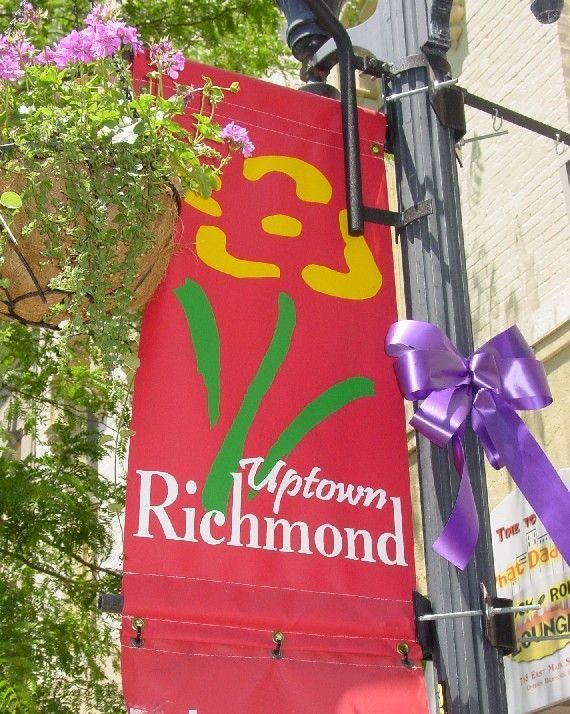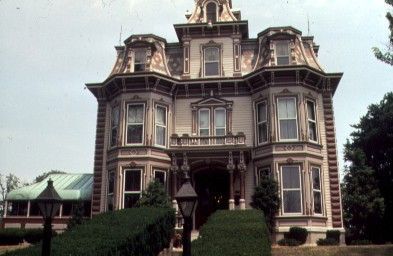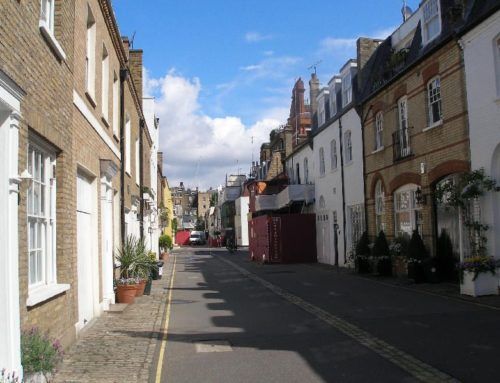See Richmond First
 In the late 1910s, Orville O. Hiestand and Charles J. Herr* set off to “see America first.” They decided to ignore Horace Greeley’s advice of “Go west young man, go west!” and the allure of far-off European destinations. Instead, the two gentlemen struck out from Richmond, Indiana to explore the Mid-Atlantic and Northeastern United States. The first leg of their trip was on the Old National Road, originally known as the Cumberland Road due to its origin in Maryland. (Today it is renamed U.S. Route 40, but most interstate travel is on I-70, which parallels and shadows U.S. 40 for hundreds of miles.)
In the late 1910s, Orville O. Hiestand and Charles J. Herr* set off to “see America first.” They decided to ignore Horace Greeley’s advice of “Go west young man, go west!” and the allure of far-off European destinations. Instead, the two gentlemen struck out from Richmond, Indiana to explore the Mid-Atlantic and Northeastern United States. The first leg of their trip was on the Old National Road, originally known as the Cumberland Road due to its origin in Maryland. (Today it is renamed U.S. Route 40, but most interstate travel is on I-70, which parallels and shadows U.S. 40 for hundreds of miles.)
What ensued was a fifty-day journey by car through Ohio, West Virginia, Pennsylvania, Maryland to see the sights of Washington, DC. Then back on the road north to Philadelphia and then east to the Atlantic seaboard and the cities of Atlantic City, New York, Providence, Newport, Boston and out to Cape Cod. Starting home, they visited Lake Champlain and Lake George in New York, Albany and the Catskill and finally Niagara Falls. When the two gentlemen got home, they wrote a book about their adventures together, called See America First. It’s out of print, but you can click on the title to download a copyright-free copy from the Gutenberg Project.
Turning the Tables
I have decided to turn the tables and take a closer look at Richmond, Indiana itself. Richmond is conveniently situated half way between Columbus and Indianapolis, right on the Indiana/Ohio border. Anyone traveling across country on I-70 will naturally be tempted to stop for the night in either of the two cities. But that’s probably because they don’t know what the Richmond area has to offer.
 As you drive, there are countless welcome signs along America’s interstates, but it’s extremely hard to gauge what lies down the off ramp. The town of Richmond and Wayne County has a fine visitor’s center and Website, www.visitrichmond.org, that can help you plan a visit, but I wanted to add in my own perspective. There are numerous ways to look at any one destination, all of them valid. But for this exercise, I am decided to frame my discussion around the social and historical processes, as well as some of the human stories, that have contributed to the area’s sense of place over the past two centuries starting with the place.
As you drive, there are countless welcome signs along America’s interstates, but it’s extremely hard to gauge what lies down the off ramp. The town of Richmond and Wayne County has a fine visitor’s center and Website, www.visitrichmond.org, that can help you plan a visit, but I wanted to add in my own perspective. There are numerous ways to look at any one destination, all of them valid. But for this exercise, I am decided to frame my discussion around the social and historical processes, as well as some of the human stories, that have contributed to the area’s sense of place over the past two centuries starting with the place.
Retreating glaciers from the last ice age left the spectacular Whitewater River Gorge and Thistlethwaite Falls. Over the next few millennia, the Richmond area became forested and all accounts tell of the beauty of the valley and its bountiful natural resources. Native Americans used the valley’s forests, rivers and streams for hunting and fishing. In 1806, the valley’s fertile soil, ample timber, an abundance of limestone and shale for building, and good water supply attracted Quaker settlers from North Carolina who were trying to escape the slave culture of the South. Many other settlers, including many Germans from Pennsylvania, sought relief from the economic conditions in the eastern United States following the War of 1812.
In the 1800s, the gorge was essential to Richmond’s growth as a source of water power and raw materials, and eventually as a site for its many industries. By the time Hiestand and Herr set off from Richmond, the town of just under 27,000 was one of the wealthiest cities in America a wealth built on the town’s rich manufacturing heritage fueled by the Industrial Age.
Millionaire’s Row
Since that time, many sites in and around Richmond have made it into the National Register of Historic Places (NRHP). Other historic sites dot the surroundings towns and fields, including a pioneer cemetery and a site of the Underground Railroad. In the town of Richmond, Millionaire’s Row is just outside the main shopping district and across from Glen Miller Park. The street is lined with Victorian mansions (several on the NRHP list) that were once homes to its prominent citizens (by address), such as:
- 1829 E. Main St.–Henry and Alice Gennett – Piano & photograph manufacturer (Gennett Records)–, NRHP for Colonial Revival architecture and performing arts history
- 1903 E. Main St.–Elwood W. McGuire – Dillie & McGuire Manufacturing – lawn mower manufacturer
- 1907 E. Main St.–John A. Hasecoster – architect who built several Richmond mansions, emigrated to America from Germany in 1867, also designed Morrisson-Reeves Library
- 2037 E. Main St.–E.G. Hill World renowned rosarian (owner of Hill Roses, which used to be the largest grower of roses underglass until early 1990s)
- 2039 E. Main St.–Philip W. Smith owned five lumber mills in the Midwest (now, Philip W. Smith B & B), Queen Anne architecture
- 2221 E. Main St.–Mordecai Parry – owner of extensive and valuable real estate (now, Martha E. Parry B & B),Early Colonial Revival architecture
You can easily find these mansions if you take a drive just east of the downtown on Main Street. But I also recommend taking a little tour back into the surrounding neighborhood. You will get a glimpse of real Americana.
Richmond’s old historic train depot district is a step back in time. Many of its warehouses, built in Late Victorian and Classical Revival architecture, are abandoned, but others are being bought and turned into businesses such as furniture stores and restaurants like Joe’s Pizza. Another nearby warehouse has been turned into Charlie’s Coffee Bar & Gallery.
 Unknown by many people, the town of Richmond played a significant role in the history of American jazz. It was the headquarters of Gennett Records, credited with the birth of recorded jazz. Its parent company was the Starr Piano Company. Louis Armstrong was early jazz singer to record at the studios. Sadly, there are little physical remains of the original studios, but the Starr-Gennett Foundation is dedicated to preserving and promoting the legacy of the two companies, their contributions and place in the music world.
Unknown by many people, the town of Richmond played a significant role in the history of American jazz. It was the headquarters of Gennett Records, credited with the birth of recorded jazz. Its parent company was the Starr Piano Company. Louis Armstrong was early jazz singer to record at the studios. Sadly, there are little physical remains of the original studios, but the Starr-Gennett Foundation is dedicated to preserving and promoting the legacy of the two companies, their contributions and place in the music world.
On September 8, 2007, the foundation will install ten commemorative medallions in the sidewalk across from the old studios. This could be likened to the Hollywood Walk of Fame. The first ten medallions will include those for: Louis Armstrong, Gene Autry, Bix Beiderbecke, “Big Bill” Broonzy, Hoagy Carmichael, Vernon Dalhart, Georgia Tom (Thomas A. Dorsey), “Jelly Roll” Morton, Joe “King” Oliver, and Lawrence Welk, who made his first recordings at the Gennett studio. I have visited this site, and currently, there is not too much to see, but the vacant administration building, which is listed on the National Register of Historic Places. I am told there are plans to create a museum on the site, but currently, you can see a small exhibit of the Starr-Gennett Foundation at the aforementioned Charlie’s Café and another selection at the Wayne County Historical Society.
Out and About Richmond
If we include the surroundings town within a few miles of Richmond, there are many more sites of interest. On a recent trip to Richmond, I stayed in the town of Centerville in the Historic Lantz House Inn. This inn, which is a really a complex of three buildings, is located directly on the Old National Road, so at one time it received visitors traveling by horse and carriage. The grounds sports five small well-groomed gardens to relax in away from the hustle and bustle of the interstate. From July 21-26, 2008, Centerville will host the Centennial Party of the Model-T Ford, which is being dubbed as the “largest gathering of the Model-T since they left the factory.” For more details, check out www.mtfca.com.
In a little town just north of Richmond called Fountain City, you can visit one of the most important stops along the Underground Railroad and NRHP site. Levi and Catherine Coffin were among the peace-loving and anti-slavery Quakers who settled this area of Indiana. Their humble eight-room Federal-style brick house, now called the Levi Coffin House, is credited with giving safe haven to more than 2,000 runaway slaves on their journey to Canada.
The hiding place was in a space in one of the bedrooms, but I was most fascinated with the well in the kitchen basement. Fountain City is so named because it sits over a high aquifer. With the indoor well, the family did not need to go outside to pump water, which helped with security.

Since Indiana is an agricultural state, it’s not surprising to find several Richmond-area farms on the NRHP list. One of the most interesting is the Abram Gaar House and Farm just north and east of Richmond, and just inside the I-70 bypass. Maplewood, as it is called by the family, is open to the public the first and third Sundays during June, July and August and the first three Sundays in December for the holidays. The three-story Late Victorian house was designed John A. Hasecoster, the same Richmond architect who built several houses on Millionaire’s Row. It was added to the list in 1975 for its connections to agriculture, architecture, and industry.
Abraham Gaar was a German immigrant who resettled in the community from Virginia in 1807. By the 1840s, the Gaar family had made a fortune manufacturing threshing machines and steam engines. In 1876, it was Abraham’s grandson Abram and his family who built Maplewood at a cost of $20,000. The property was continuously occupied by a member of the Gaar family until the late 1990s. Today, the house which is owned by the Agnes and Abram Gaar Foundation and overseen Sarah Bradley, the great-great-granddaugher of Abram Gaar.
Maplewood Mansion, as I would call it, is a remarkable example of nineteenth-century rural livingalthough it is safe to say few rural residents lived so well at the time. The imposing house sits on the top of a hill at the end of a long, tree-lined drive. The interior is as splendidly Victorian as the exterior. Over the years the house has been preserved and restoredit still has its original walnut woodwork and parquet floors in the family rooms and wide plank floors in the servants quarters. The first floor is decorated with cast iron French fireplaces, crystal gas chandeliers and embossed leather wainscoting and ninety percent of the original family furnishings. The second floor contains the family bedroom and a guest room, while the third floor was the servants quarters and a game room. The kitchen stills has the original wood-burning stove.
Other historic farms include the Samuel G. Smith Farm which lies just west of Richmond, the Westcott Stock Farm, although it’s surrounded by a subdivision of Centerville, and King-Dennis Farm in the countryside northwest of Richmond.
A Pioneer Cemetery
Another interesting NRHP property is Doddridge Cemetery a fine example of America’s pioneer cemeteries named for one of the area’s earliest settlers. I love pioneer cemeteries. They have so much character and are intrinsically tied to an area’s culture and history. The cemetery still has a working chapel whose records date back to 1818 offering a rich documentation of the exploration and settlement of the area, as well as the westward movement of Methodism in the nineteenth century.
Nineteen members of the Doddridge family relocated to the Richmond area after a Pennsylvania a scouting party pronounced the land to be a “paradise that would satisfy every human need.” The land they settled on fell inside the Twelve Mile Purchase, land bought by the United States government from the Native Americans around 1800 and sold at auction for $2.00 an acre. They came down the Ohio River by flatboat, disembarked at Cincinnati (the then “gateway to the west”) and then took a 60-mile wagon ride north along old Indian trails to arrive at their new home.
The Doddridge settlers were God-fearing and in 1816 two family members donated the land, materials and labor to build a log church on the property. The still standing “new” church was erected in 1876. Subsequently, the church became the “fountainhead of deep religious experiences” and was the site of many camp meetings and revivals up until the 1950s.
Today all is quiet. I visited one evening with the hopes of finding the graves of five Indian supposedly buried there. I was unsuccessful, but later learned they are buried in the original southwest section of the cemetery, in five unmarked graves “eighteen feet east” of the graves of early settlers John Spahr and Sabra Doddridge Spahr. Doddridge Cemetery, located seven miles southwest of Centerville and thirteen miles southwest of Richmond, is a drive well worth the step back in time.
I have decided I must return to Richmond. I want to see Maplewood at Christmas time and some of the other historical farm properties. I want to take a closer look at Millionaire’s Row–and perhaps stay in one of the B&Bs. I want to explore its natural resources, especially the Whitewater River Gorge. And I encourage you to take the off ramp, too.
*Ironically, Charles J. Herr, a well-known lumber company manager in the Richmond area, died in a car accident on April 27, 1929 at the age of 58. I have yet to be able to find more definitive information about Orville O. Hiestand. If you have information on either of these gentlemen, I would love to hear from you. Click on my “contact me” button in the pink column to see my email address.
Additional Reading:
Hartig, James P. and Ward, Gertrude, L. (1991). Gaar Houses: Richmond, Indiana. Centerville, Indiana: Neighborhood Preservation Services, Inc.
Hiestand, Orville O., & Herr, Charles J. (1922).See America First. Chicago: Regan Printing House.
Mikesell, Joanna Hill and Warfel, Annette S. (1999). The Gaar Family: Pioneers of Industry. Richmond, Indiana: Prinit Press.
Tomlan, Mary Raddant, & Tomlan, Michael A. (2003).Richmond, Indiana : its physical development and aesthetic heritage to 1920. Indianapolis: Indiana Historical Society.
For more information:
Abram Gaar House & Farm
2593 Pleasant View Road
Richmond, IN 47374
http://www.waynet.org
Doddridge Chapel and Cemetery
9465 Chapel Rd.
Centerville, IN 47330
Levi Coffin House
115 N. Main St.
Fountain City, IN47341
(765) 847-2432
Starr Piano Co. Warehouse & Administration Building
300 S. 1st St.
Richmond, IN 47374
Starr-Gennett Foundation, Inc.
33 South 7th Street
Richmond, IN 47374
(765) 962-1511
www.starrgennett.org
info@starrgennett.org
Philip W. Smith B&B
2039 E Main St.
Richmond, IN 47374
(765) 966-8972
www.pwsmithbnb.com
Martha E. Parry B&B
2221 E. Main St.
Richmond, IN 47374
(765) 966-8972
www.pwsmithbnb.com
King-Dennis Farm
2939 King Rd.
Centerville, Indiana 47330
Richmond~WayneCounty Convention & Tourism Bureau
5701 National Road East
Richmond, IN 47374
800-828-8414
765-935-8687
www.visitrichmond.org
Samuel G. Smith Farm
3431 Crowe Rd.
Richmond, IN 47374
Wayne County Historical Society
1150 North A Street
Richmond, IN 47374
(765) 962-5756
Westcott Stock Farm
306 East North St.
Centerville, IN 47330



